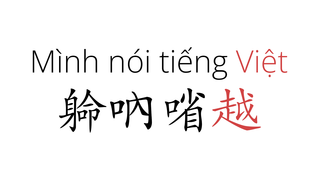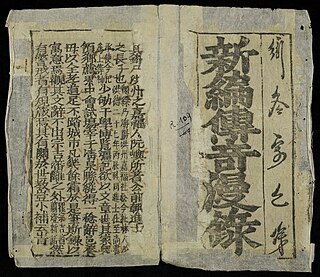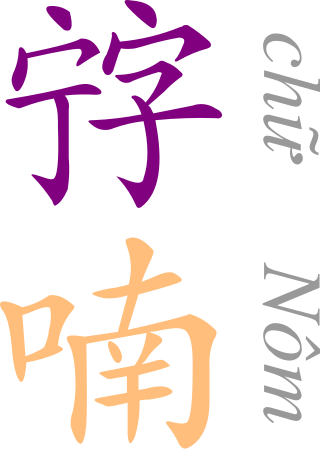Articles related to Vietnam and Vietnamese culture include:
The Three Character Classic, commonly known as San Zi Jing, also translated as Trimetric Classic, is one of the Chinese classic texts. It was probably written in the 13th century and is mainly attributed to Wang Yinglin during the Song dynasty. It is also attributed to Ou Shizi (1234–1324).

Spoken and written Vietnamese today uses the Latin script-based Vietnamese alphabet to represent native Vietnamese words, Vietnamese words which are of Chinese origin, and other foreign loanwords. Historically, Vietnamese literature was written by scholars using a combination of Chinese characters (Hán) and original Vietnamese characters (Nôm). From 111 BC up to the 20th century, Vietnamese literature was written in Văn ngôn using chữ Hán, and then also Nôm from the 13th century to 20th century.

The Trần dynasty,, officially Great Việt, was a Vietnamese dynasty that ruled from 1225 to 1400. The dynasty was founded when emperor Trần Thái Tông ascended to the throne after his uncle Trần Thủ Độ orchestrated the overthrow of the Lý dynasty. The Trần dynasty defeated three Mongol invasions, most notably during the decisive Battle of Bạch Đằng River in 1288. The final emperor of the dynasty was Thiếu Đế, who was forced to abdicate the throne in 1400, at the age of five years old in favor of his maternal grandfather, Hồ Quý Ly.
Vietnamese literature is the literature, both oral and written, created largely by the Vietnamese. Early Vietnamese literature has been greatly influenced by Chinese literature. As Literary Chinese was the formal written language for government documents, a majority of literary works were composed in Hán văn or as văn ngôn. From the 10th century, a minority of literary works were composed in chữ Nôm, the former writing system for the Vietnamese language. The Nôm script better represented Vietnamese literature as it led to the creation of different poetic forms like Lục bát and Song thất lục bát. It also allowed for Vietnamese reduplication to be used in Vietnamese poetry.

Dương Triệu Vũ is the stage name of Tuấn Linh, a singer on the popular Vietnamese diaspora music show Paris By Night.

Paris By Night 97 - Khiêu Vũ Của Các Ngôi Sao 2 is a Paris By Night program produced by Thúy Nga that was filmed at Knott's Berry Farm on April 22, 2009 and released onto DVD September 7, 2009. The show was approximately 5 hours and was MC'ed by Nguyễn Văn Thinh and Nguyễn Cao Kỳ Duyên.

Bình Ngô đại cáo was an announcement written by Nguyễn Trãi in 1428, at Lê Lợi's behest and on Lê Lợi's behalf, to proclaim the Lam Sơn's victory over the Ming imperialists and affirm the independence of Đại Việt to its people.

The Đại Việt sử lược or Việt sử lược is an historical text that was compiled during the Trần dynasty. The three-volume book was finished around 1377 and covered the history of Vietnam from the reign of Triệu Đà to the collapse of the Lý dynasty. During the Fourth Chinese domination of Vietnam, the book, together with almost all official records of the Trần dynasty, was taken away to China and subsequently collected in the Siku Quanshu. The Đại Việt sử lược is considered the earliest chronicles about the history of Vietnam that remains today.

Nguyễn Quảng Tuân was a writer, poet and researcher in South Vietnam. He was born in the village of Yên Mẫn, the district Võ Giàng, the province of Bắc Ninh, northern Vietnam.

The Truyền kỳ mạn lục is a 16th-century Vietnamese historical text, in part a collection of legends, by Nguyễn Dữ (阮嶼) composed in Classical Chinese. The collection was translated into French by UNESCO in 1962. Nguyễn Thế Nghi (阮世儀) translated this work into Vietnamese. His work is called Tân biên truyền kỳ mạn lục (新編傳奇漫錄).

Chữ Nôm is a logographic writing system formerly used to write the Vietnamese language. It uses Chinese characters to represent Sino-Vietnamese vocabulary and some native Vietnamese words, with other words represented by new characters created using a variety of methods, including phono-semantic compounds. This composite script was therefore highly complex and was accessible to less than five percent of the Vietnamese population who had mastered written Chinese.
Lý Thị Ngọc Kiều, dharma name Diệu Nhân (妙因), was a princess during the Lý dynasty in Vietnamese history. She was the 17th leader of the Vietnamese Vinītaruci school of Buddhism.

Đặng Huy Trứ was a Vietnamese official of Nguyễn dynasty.

Hoàng Yến Chibi is a Vietnamese singer, actress and model. She lives in Ho Chi Minh City.

Chữ Hán is the term for Chinese characters in Vietnamese. Chữ Hán are used to write Literary Chinese and Sino-Vietnamese vocabulary in the Vietnamese language. They were officially used in Vietnam after the Red River Delta region was incorporated into the Han dynasty and continued to be used until the early 20th century where usage of Literary Chinese was abolished alongside the Confucian court examinations causing chữ Hán to fall into obscurity.

The abdication of Bảo Đại took place on 25 August 1945 and marked the end of the 143-year reign of the Nguyễn dynasty over Vietnam ending the Vietnamese monarchy. Emperor Bảo Đại abdicated in response to the August Revolution. A ceremony was held handing power over to the newly established Democratic Republic of Vietnam, which was established during the end of World War II in Asia as Vietnam had been occupied by French and later Japanese imperialists.

Tự Đức thánh chế tự học giải nghĩa ca is a Vietnamese book that teaches Chinese characters through chữ Nôm. It was complied by the emperor of the Nguyễn dynasty, Tự Đức (1848–1883), around the 19th century. The book itself contains 13 volumes which are organized into 7 major categories. It is written in the Vietnamese lục bát 六八 verse form. It is considered to be an important dictionary for chữ Nôm researchers as it is a fairly complete Hán-Nôm dictionary with no ambiguous characters.


















